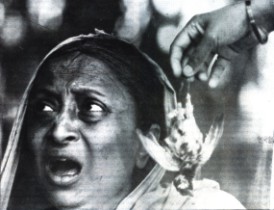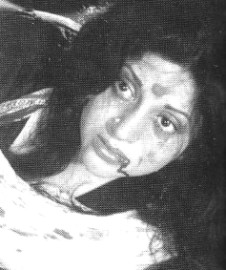 |
Soovas Dutt and Kabori in Shutarang in the early 60s. |
Heritage
Recording the History of Cinema
Audity Falguni
Black and white rare posters of decades-old films from the East Pakistan or early Bangladesh era, piles of old cine magazines or reels of 35 mm films to be cleaned before the cleaning machine...Bangladesh Film Archive (BAF) is overflowing with nostalgic material. It contains the tale of evolution of our cine industry with all its short-comings and a handful of achievements. Situated in the busy Shahbagh area of the city, the archive bears the testimony of the nation's journey in the realm of movies.
Bangladesh Film Archive (BAF) was established as `Film Institute and Archive' under the auspices of the Ministry of Information in 1978. Later, it was renamed as 'Bangladesh Film Archive' in 1984 and it is now functioning as the lone national institution to collect, preserve and research on all the films and film-related materials of our country, according to the film archive officials.
The BAF attained the membership of the Brussels-based 'International Federation of Film Archives (FIAF)' in 1980 along with other 140 countries of the world. The Archive can exchange and collect rare films with all the member countries under FIAF umbrella, according to archive sources.
Since the establishment of BAF, it has been endeavouring to preserve all the available native and foreign films. Right now we have a valuable collection of 2269 native and foreign films including full length and short length films, documentaries and prints and negatives of news documentaries. According to librarian Mohammad Nazrul Islam, of the remarkable reputed films of our country, there are the prints of films like Mukh o Mukhosh (Face and the Masks, 1956), Asia (1960), Nadi o Nari (River and the Women), Palanka (The Bed), Titas Ekti Nadir Nam (Titas, the name of a river), Jiban theke Neya (Taken from Life), Stop Genocide, A State is Born, Ora Egaro Jan (Eleven Freedom Fighters), Alo ar Michil (The Road March of Light), Hangar Nadi Grenade (Shark River Grenade), Aguner Parashmoni (The Touch Stone of Fire)".
"Again, the Archive Library contains around 55,000 documents" says Islam. "Of those there are around 3134 books related to films, 14,575 still photographs, 6677 posters, 1986 screenplays, 278 books of songs, 1365 brief synopsis of films, 839 documents relating to various International film festivals, 12,733 news clippings related to films, 9963 periodicals and 3834 other documents. Apart from it, we have a neat collection of 897 CDs and VCDs of different films".
 |
| Roushan Jamil in Surya Dighal Bari. |
The major bottleneck of the BAF faces, however, is a severe shortage of staff, says Abdus Sattar Miaji, the Director of BAF. "The total manpower in BAF sums up only 38 with one Director General, one Director, five second class gazette officials, 25 third class gazette officials and six fourth class gazette officials. It is really difficult to handle the affairs of our five sections namely the film, library, administration, accounts and store sections with help of so few people. We submitted a proposal of a new organisational frame-work with the recommendation of 125 posts to the Ministry of Information nearly three or four years ago. The sole objective was to modify the existing official structure of BAF. We are, however, yet to receive any answer from the Ministry".
He adds that the running fiscal year of 2008-09, our total amount of allotted budget amounts to 1,33,67,000 BDT. In the 2007-08 fiscal year, BAF conducted four research studies with the development budget fund and three research studies with the revenue budget. "All the researches were aimed at analysing different trends and issues of our mainstream commercial movies and alternative art films as well, children's films and portrayal of women on screen" he adds. Last year, the first issue of 'Banlgadesh Film Archive Journal' was also published.
While roaming around within the film archive office, one noticed the cleaning process of old films. "Owing to manpower shortage, here we are just two cleaners in this office" says the cleaner working before the machine. "But, for proper cleaning and maintaining of around 2300 films, we need at least 10-15 cleaners. A number of films are thus getting wasted."
"Despite all the existing problems of Bangladeshi film industry" says Mohammad Jahangir, the Director General of the BAF, "including our struggle with obscenity, piracy of songs and screenplays from foreign movies, distraction of educated middle class from the cinema halls, younger generations' inclination towards Bollywood and Holywood movies, we have also some achievements."
 |
Babita the heartthrob of the 70s. |
"Just imagine those passionate early film-makers and artists who had to challenge the conventional mind-set of our very conservative society during the decades of late forties to early fifties" says Jahangir. "During that time, acting in a movie was considered almost an `act of sin' in the middle-class community of East Bengal. The embargo was again too rigid upon the female section of the population. But, well... male and female performers like Zaharat Ara, Shabnam, Rahman, Suchanda, Kabari, Razzak, Khan Ata, Sujata, Azim, Shabana, Babita or eminent and pioneer makers like Zahir Raihan, Subhas Dutta, Ehtesham, Alamgeer Kabir or Amjad Hossain breached the social taboo, hoisted the flag of Bengali culture amidst the invasion of Urdu movies in the Pakistani period, reflected the socio-political reality of East Pakistan and a fighting nation to achieve Independence in the war of 1971 in their films...you cannot simply overlook and ignore those facts".
Films like Surya Dighal Bari, Sutarang, Emiler Goyenda Bahini, Agami, Matir Mayna, Chitra Nadir Pare, Lalon, Swapnadana have obtained huge recognition at the national, regional and international level. If the government becomes more supportive like the West Bengal Provincial government of India to grant a handsome amount of money to young and alternative film-makers, many more talents can come and change the scenario with their creative fire, Jahangir opines.
A pro-socialist government's contribution in the arena of culture in West Bengal, India could have made possible the emergence of a number of great film makers like Satyajit Ray, Mrinal Sen, Budhdhadev Dashgupta, Gautam Ghosh or Aparna Sen. Mohammad Jahangir feels that the government should be more encouraging to filmmakers like Tanvir Mokammel, Morshedul Islam, Tareq and Catherine Masud, Shamim Akhter, Yasmeen Kabir or the younger ones like Shabnam Ferdousi, Fauzia Khan and others in order to help this industry grow and flourish.
Copyright
(R) thedailystar.net 2009 |
